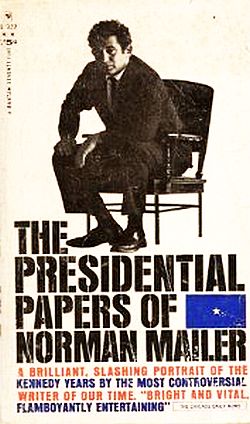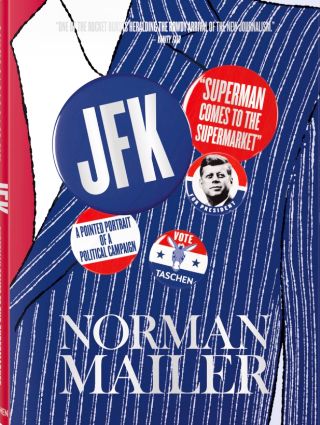
Cover of Taschen’s “JFK/Norman Mailer” book, featuring 300 JFK campaign photos built around Mailer’s famous November 1960 Esquire magazine piece – “Superman Comes to The Supermarket.”
Mailer – along with a few other leading literary lights of his day, including Tom Wolfe, Gay Talese, and Truman Capote – became one of the key innovators of the “new journalism,” a genre of creative nonfiction that applied the method and style of literary fiction to fact-based journalism. Mailer’s piece on JFK – utilizing this methodology – became one of the earliest and notable examples of the new style.
In 1960, Clay Felker, editor at Esquire, recruited Mailer to do a piece on the rising U.S. Senator from Massachusetts, John F. Kennedy, then seen as the front-runner and likely to land the Democratic presidential nomination at the national convention that summer in Los Angeles, California. Mailer went to the week-long convention and immersed himself in Democratic politics and the Kennedy organization. The resulting piece, “Superman Comes to the Supermarket,” was a long, laudatory piece on Kennedy published in Esquire three weeks before the November 1960 presidential election. The Esquire article became famous both as a piece of new journalism and a new kind of political reporting – and a piece Mailer believed brought votes to Kennedy.
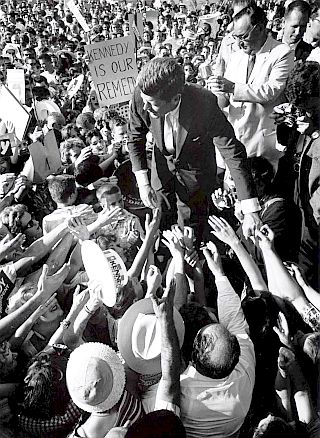
September 9, 1960. A sea of hands surge toward JFK in Los Angeles. Buttressed by California Governor Pat Brown — one of many former rivals for the Democratic nomination —Kennedy enjoyed the full support of his party by the time of the general campaign. Photo, Stanley Tretick (from Taschen book).
In November 2014, more than 50 years after Kennedy’s election and Mailer’s groundbreaking reporting, the two historic events comprise the focus of a spiffy new book by the upscale Taschen publishing house, titled: JFK: Superman Comes to the Supermarket, Norman Mailer. The 370-page book is both an exploration of John F. Kennedy and Norman Mailer, as it features in great and glorious detail some 300 Kennedy campaign and inauguration photographs built around Mailer’s Esquire piece and other Mailer writing, as well as selected passages and quotes from Kennedy campaign speeches.
The book covers JFK’s bid for the White House, mostly his 1960 campaign and through his Inauguration in January 1961. Aided by some of the best photographers of that era – including Cornell Capa, Henri Dauman, Jacques Lowe, Lawrence Schiller, Paul Schutzer, Stanley Tretick, Hank Walker, Garry Winogrand, and Burton Berinsky – the pages come alive with the optimism, energy and activity that Kennedy brought to those hopeful days of 1960-1961.
Taschen, an art book publisher founded in 1980 by Benedikt Taschen in Cologne, Germany, has published thousands of titles across a range of topics found online and at Taschen book shops globally. The Mailer-Kennedy book is edited by Nina Wiener, who has dozens of titles under her belt at Taschen, including Walton Ford’s Pancha Tantra, Norman Mailer’s MoonFire, and Lawrence Schiller’s Marilyn & Me. J. Michael Lennon, Mailer’s biographer, has two top-rate essays on Mailer framing the book – one to introduce the work and another at the end on Mailer’s career. Jack Doyle, editor and publisher of this website, The Pop History Dig, contributed captions and two Kennedy chronologies to the book, and is also the author of this post.

April 1960: JFK perched precariously on high chair as he addresses a gathering in Logan County, West Virginia during that state’s primary election. Photo, Hank Walker.
Kennedy Campaign
After J. Michael Lennon’s introductory essay in the book setting up the Mailer essay and the Kennedy context, the reader is taken through a series of four chapters organized around JFK’s 1960 campaign – announcing his bid for president and winning key primary elections, notably in Wisconsin and West Virginia; maneuvering and politicking for votes and delegates at the Democratic Convention in Los Angeles in July 1960 to secure his party’s nomination; debating his opponent, Republican Vice President Richard Nixon in four historic TV debates; campaigning frenetically throughout the nation in the fall campaign; enduring a long election-night vote count with a next-day concession from Richard Nixon; and finally, becoming President of the United States on Inauguration Day, January 1961. These four chapters entail the meat of the book, and capture all the energy and excitement of that historic 1960-61 presidential season.
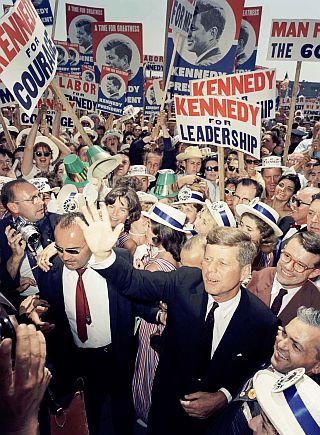
July 9, 1960: JFK makes his way through a crowd of supporters and journalists upon his arrival at the Democratic National Convention in Los Angeles.
“We have the most gadgets and the most gimmicks in our history, the biggest TV and tail-fins — but we also have the worst slums, the most crowded schools, and the greatest erosion of our natural resources and our national will. It may be, for some, an age of material prosperity — but it is also an age of spiritual poverty.”
Subsequent sections of the book include two important timelines – “A Road to The White House,” chronicling JFK’s campaign with important dates and events from January 1960 through Inauguration Day, January 21, 1961, and, “John F. Kennedy: A Life,” a biographical timeline, from his May 29, 1917 birth through his tragic assassination of November 22, 1963. These timeline sections are also peppered with relevant photos.
“The Candidate in Print” is also found in the latter half of the book – a section which Kennedy fans and political historians of all stripes, as well as those interested in magazine and newspaper history, will find of special interest. This ten-page spread includes a rare cross-section of magazine covers, print articles, newspaper front pages, brochures and other material pertaining to JFK’s various campaigns – dating from his early U.S. Navy days, House and Senate years, through his presidency.
|
“Mailer’s Boast”  Norman Mailer in 1969, when he ran for Mayor of New York, in front of campaign poster and slogan for he and running mate Jimmy Breslin, “Vote the Rascals In.” “…So if I came to the cool conclusion I had won the election for Kennedy with my piece in Esquire, the thought might be high presumption, but it was not unique. I had done some-thing curious but indispensable for the campaign — succeeded in making it dramatic. I had not shifted one hundred thousand votes directly, I had not. But a million people might have read my piece and some of them talked to other people. The cadres of Stevenson Democrats whose morale was low might now revive with an argument that Kennedy was different in substance from Nixon. Dramatically different. The piece titled ‘Superman Comes to the Supermarket’ affected volunteer work for Kennedy, enough to make a clean critical difference through the country. But such counting is a quibble. At bottom I had the feeling that if there were a power which made presidents, a power which might be termed Wall Street or Capitalism or The Establishment, a Mind or Collective Mind of some Spirit, some Master, or indeed the Master, no less, that then perhaps my article had turned that intelligence a fair hair in its circuits. This was what I thought. Right or wrong, I thought it, still do.” [From “An Evening With Jackie Kennedy, or, the Wild West of the East,” Esquire, July 1962]. 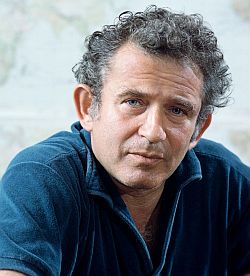 Norman Mailer, August 1969. |
The photos throughout the Mailer-JFK book, meanwhile, are vivid with the action of Kennedy’s run for the White House, whether glimpsing insider arm twisting at the convention, or simply capturing average folks across America who came out in droves to seen the new young candidate. But it’s all here. From Kennedy family members campaigning for their favorite son, to reporters, TV correspondents, and photographers gathering in the scenes and events of the 1960 campaign. Editor Nina Wiener and her staff worked long hours and scouted wide and far to find, catalog, and arrange just the right photos to capture and convey key moments and personalities in the Kennedy story. No detail was too small. Even the remarks and views of campaign photographers are used to good effect throughout the book – for these behind-the-lens travelers got to know the candidate as well, if not better than, many political pundits of that day. The Democratic National Convention – held in Los Angeles that July 1960 – is a highpoint of the book’s photographic coverage and of Mailer’s analysis.
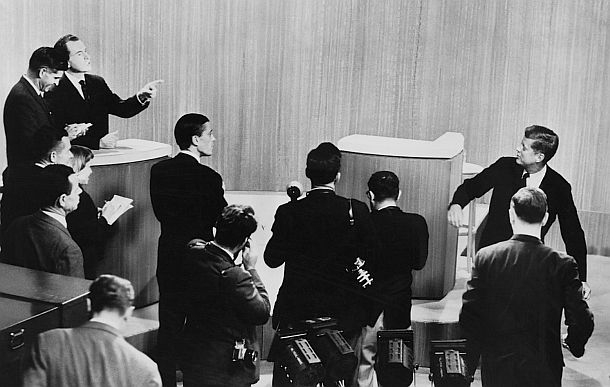
October 21st, 1960: Richard Nixon, far left, pointing, appears to be trying to score on last rejoinder as JFK leaves the stage after their 4th nationally-televised presidential debate. Taschen’s Norman Mailer-JFK book covers all four of the debates, on stage and off, presenting photographs like this one, which capture some of the “post-game” action.
Hollywood celebrities populate this book as well – among them, Frank Sinatra, Judy Garland, Janet Leigh, Tony Curtis, and Sammy Davis, Jr. Political stars and rival contenders are central to the photographic story and are found throughout the book, including Adlai Stevenson, Lyndon B. Johnson, Hubert Humphrey, Eleanor Roosevelt, then Speaker of the House Sam Rayburn, and others. Teddy and Bobby Kennedy are here as well, often doing advance work on the campaign trail or negotiating over delegates. Jackie Kennedy is seen campaigning alongside Jack at a number of locations in 1959 and 1960, although her pregnancy kept her sidelined for much of the 1960 campaign. And as this book acknowledges, Jackie was a highly regarded campaign presence. JFK, of course, is shown in confident and forceful tones throughout, as well as in his weary and pensive moments – all cast in the unique angle and light of each photographer’s particular style.
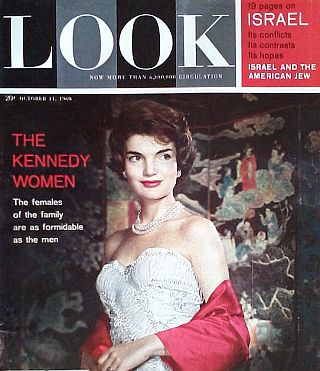
October 11th, 1960: Look magazine ran a portion of the full 1957 portrait photograph of Jackie Kennedy on its cover taken by Yousuf Karsh, which appears in a richer full version in the Taschen Norman Mailer /John F. Kennedy book.
Jackie Kennedy
A special treat for Jackie Kennedy fans comes near the end of the book in a section titled “An Evening With Jackie Kennedy,” which recounts Mailer’s 1960 visits with, and impressions of, Jackie at Hyannis Port, home of the Kennedy compound and the soon-to-be “summer White House.”
Among Mailer’s impressions of Jackie at that meeting: “…There was something quite remote in her. Not willed, not chilly, not directed at anyone in particular, but distant, detached as the psychologists say, moody and abstracted the novelists used to say…”
And also this: “…I liked Jackie Kennedy, that she was not at all stuffy, that she had perhaps a touch of artful madness which suggests future drama….”
In this section of the book, there is also the stunning full-page, full-color portrait photo of a young Jacqueline Kennedy in 1957 taken by famed portrait photographer Yousuf Karsh at Hammersmith Farm in Newport, Rhode Island.
“She may have been all American,” says the Taschen caption, but Karsh that day “made royalty out of [her].” The Karsh photo also appeared on the cover of Look magazine during the election campaign in October 1960.
And last but not least in the Taschen book is “Norman Mailer: A Brief History,” by J. Michael Lennon, which not only includes a concise look at Mailer’s sprawling and productive career, but also a sample page of Mailer’s “Superman” manuscript showing the master’s handwritten edits as he made them on a later typewritten draft. In his essay, Lennon offers a fine summary of Mailer’s career, as follows:. . . Mailer is the only person to win Pulitzers in both fiction and nonfiction. Five of his books have been finalists for National Book Awards, including Of a Fire on the Moon (1971), his nonfiction narrative of the Apollo 11 moon shot, which was serialized in Life. . . . He won a second Pulitzer for The Executioner’s Song (1979), an account of the life and death of Utah murderer Gary Gilmore. He explores other lives at great length, but nowhere else does he display his acumen for psychological spelunking with such verve. Other biographical works include portraits of Muhammad Ali, Henry Miller, Pablo Picasso, Lee Harvey Oswald, Madonna, Jesus Christ, and Hitler. In 2006 he was recognized for his many contributions to literature and culture with the National Book Award Foundation’s Lifetime Achievement Award. Married six times, he was the father of nine children and had ten grandchildren. . . .
Also mentioned here is Mailer’s 1963 book, The Presidential Papers, which featured “Superman Comes to the Supermarket,” among other essays, and had gone to press just two weeks before Kennedy’s November 22nd, 1963 assassination. Mailer had hoped his ideas might win him some notice by JFK, and even a role as a White House advisor.
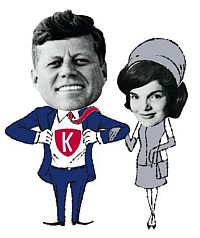
JFK & Jackie cartoon characters also appear in the Mailer-Kennedy book, by Edwin Fotheringham.
History Keepsake
All in all, the Taschen book on the Mailer-Kennedy nexus of 1960-61 hits all the right marks. It takes a unique historical cut on politics, campaigning, journalism, and photography all wrapped up in one nice package – well worth the investment as both a political history keepsake and an example of engaging political journalism.
Additional stories on publishing at this website can be found at the “Print & Publishing” category page, and on politics, at the “Politics & Culture” page. Additional Kennedy stories at this website are listed below in “Sources.”
Thanks for visiting – and if you like what you find here, please make a donation to help support the research and writing at this website. Thank you. – Jack Doyle
|
Please Support Thank You |
____________________________________
Date Posted: 5 December 2014
Last Update: 19 January 2023
Comments to: jdoyle@pophistorydig.com
Article Citation:
Jack Doyle, “Mailer on Kennedy – New Taschen Book,”
PopHistoryDig.com, December 5, 2014.
____________________________________
Sources, Links & Additional Information
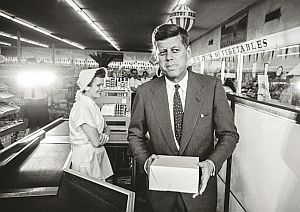 "Superman in The Supermarket": JFK visits a West Virginia grocery store in April 1960. Photo by Hank Walker from the Taschen book. |
 July 11, 1960: JFK sister Eunice (left) with sisters-in-law Joan (center) and Ethel (right) on the floor at the Democratic National Convention in Los Angeles. Jacques Lowe photo from the Taschen Mailer-Kennedy book. |
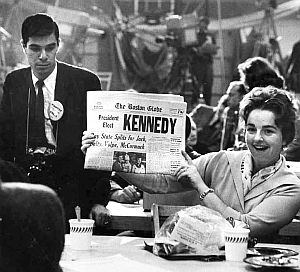 November 9, 1960: Member of the press who gathered at the Hyannis Armory through the long election night, displays a Boston Globe headline proclaiming Kennedy’s victory. Henri Dauman photo from the Taschen Mailer-Kennedy book. |
Norman Mailer, Nina Wiener, J. Michael Lennon, Norman Mailer. JFK. Superman Comes to the Supermarket, Taschen (300 photographs), November 2014, 370 pp.
“America’s First Soap Opera,” Taschen, Winter 2014, pp. 72-81.
Jill Abramson, “J.F.K.: A Sampler” (short reviews of JFK books), Sunday Book Review, New York Times, October 22, 2013 (“Superman Comes to the Supermarket” included).
James Wolcott, “One Cool Cat,” VanityFair .com, September 2010.
John F. Kennedy Presidential Library and Museum, JFKlibrary.org, Boston, MA.
Theodore H. White, The Making of the President 1960, New York: Atheneum Publishers, 1962.
Kenneth P. O’Donnell and David F. Powers with Joe McCarthy, Johnny, We Hardly Knew Ye, Boston: Little Brown & Co., 1970.
Richard Reeves, President Kennedy: Profile of Power, New York: Simon & Schuster, October 1993, 800pp.
J. Michael Lennon, Norman Mailer: A Double Life, New York: Simon & Schuster, October 2013, 960pp.
Philip French, “Lover, Fighter, Saint and Sinner – a Fascinating Biography Skillfully Traces the Contradictions That Defined Norman Mailer,” Review of Norman Mailer: A Double Life, by J. Michael Lennon, TheGuardian.com, November 30, 2013.
Norman Mailer, Colum McCann, MoonFire, The Epic Journey of Apollo 11, Taschen, June 2010, 348pp.
JFK Stories at The Pop History Dig
“JFK’s 1960 Campaign,” PopHistoryDig.com, July 20, 2014.
“JFK’s Pacific Swim: August 1962,” Pop HistoryDig.com, March 31, 2014.
“Kennedy History: 12 Stories, 1954-2013,” PopHistoryDig.com, November 10, 2013 (a “topics page” with thumbnails & links).
“JFK’s Early Campaign: 1958,” PopHistory Dig.com, August 21, 2013.
“JFK’s Texas Statue, Ft. Worth: 2012,” PopHistoryDig.com, April 17, 2013.
“The Jack Pack, 1958-1960,” (Frank Sinatra’s Rat Pack & Jack Kennedy), PopHistoryDig .com, August 21, 2011.
“JFK’s Profiles in Courage, 1954-2008” (JFK book & related history), PopHistoryDig.com, February 11, 2008.
“Murdoch’s NY Deals, 1976-1977″ (includes Clay Felker/New York magazine history), PopHistoryDig.com, September 25, 2010.
____________________________
